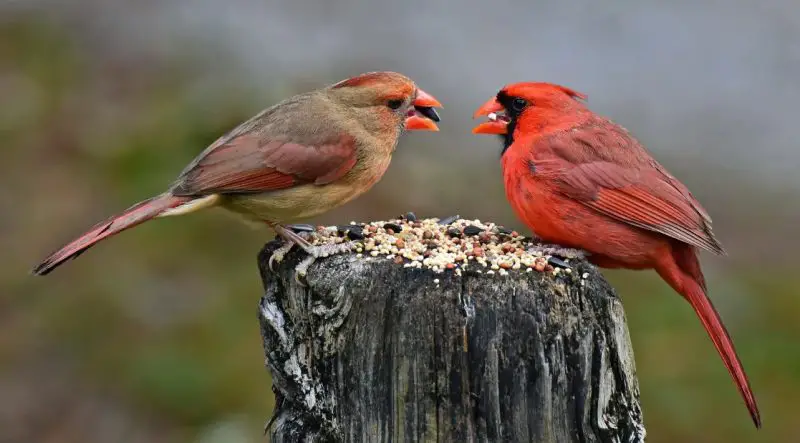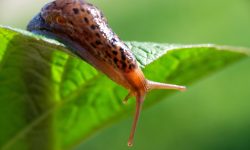Cardinals are among the most recognizable backyard birds in North America. Their brilliant red feathers, expressive crests and warm calls make them favorites for birdwatchers and nature lovers. While they frequently visit feeders, cardinals have a diverse natural diet that helps them thrive across forests, gardens, parks and rural landscapes. Understanding what cardinals eat provides insight into their survival, their seasonal movements and how they interact with their surroundings.
These birds rely on a flexible diet that shifts with the seasons. In spring and summer, cardinals eat high-protein foods that support breeding, nesting and raising young. During fall and winter, they turn to energy-rich seeds and fruits that help them maintain body heat. Their thick beaks are perfectly shaped for cracking seeds, while their active foraging behavior allows them to locate insects in leaves, shrubs and forest floors.
This guide explores 20 foods cardinals love in the wild, showing how these beautiful birds balance nutrition throughout the year. Whether you enjoy spotting them in your yard or wish to support local bird populations, understanding their diet gives you a deeper appreciation for their daily lives.
Understanding the Cardinal Diet

Cardinals are omnivores with broad feeding habits that change throughout the year. They rely heavily on seeds and fruits during colder months when insects disappear, but they shift toward insects during spring and summer when protein demands increase. Their strong, cone-shaped beaks help them crush seeds, rip open fruit skins and catch insects with surprising precision.
Unlike many migratory birds, cardinals remain in their home regions year-round. This means they must adapt to whatever food the environment provides in each season. In winter, they forage for seeds and dried berries hidden beneath snow or tucked inside shrubs. In summer, they search actively for beetles, caterpillars and other insects that support feather growth and nestling development.
Cardinals also forage at multiple heights within their habitat. They look for insects in tree branches, gather seeds from grasses or shrubs and consume fallen fruits on the ground. Their feeding range includes forest edges, backyards, woodland interiors and open fields. This flexibility helps them thrive in both wild and suburban environments.
20 Foods Cardinals Love in the Wild
1. Sunflower Seeds
Sunflower seeds are one of the cardinals’ favorite foods, offering both energy and essential fats. Their strong beaks easily crack the shells, allowing them to extract the nutritious kernels inside.
In the wild, cardinals seek out native sunflower varieties or similar seed-bearing plants. They may forage on dried flower heads still attached to stems or pick fallen seeds from the ground beneath tall plants.
These seeds are especially valuable in winter when cardinals need constant energy to stay warm and active.
2. Safflower Seeds
Safflower seeds are another favorite food that cardinals readily consume. The seeds’ hard shells are not a problem for their powerful beaks, and the rich interior offers long-lasting energy.
Cardinals encounter safflower-like seeds in prairies, field edges and gardens. These plants grow resiliently in many climates, making seeds available throughout the year depending on the region.
In wild environments, cardinals use open spaces and field borders to locate these nutritious seeds.
3. Millet
Wild millet grows in grasslands, along roadsides and in meadow-like areas where cardinals feed naturally. These tiny seeds are easy for cardinals to handle and provide moderate energy.
During late summer and fall, millet becomes abundant, offering a seasonal feast. Cardinals often pick the seeds directly from grass heads or forage on the ground where they’ve fallen.
Millet helps sustain cardinals during transitional seasons when insect populations begin to drop.
4. Ragweed Seeds
Ragweed, though disliked by many people, is a valuable plant for cardinals. Its seed clusters are rich in nutrients and remain accessible on stalks through fall and winter.
Cardinals cling to stems or hop beneath plants to extract these seeds. Ragweed thrives in disturbed areas, making it easy for cardinals to find along field edges and rural roadsides.
These seeds help cardinals stay energized during cold weather when other food becomes scarce.
5. Weed Seeds (Various Species)
Cardinals consume a wide range of weed seeds, including those from thistles, dock, plantain and dandelion-like plants. These seeds grow in abundance and provide small but steady nutritional value.
Weed-rich habitats—including meadows, fence lines and old fields—provide plentiful foraging grounds. Cardinals often hop along the ground to locate dry seed clusters.
Weed seeds diversify the cardinals’ diet, especially in environments with limited fruit or insect availability.
6. Grains
Wild grains such as barley, cracked corn and similar native species appear in farmland borders and open prairies. Cardinals browse these grains when they have access to agricultural edges.
They crack open kernels using their thick beaks and consume pieces one at a time. Grains provide carbohydrates that offer steady, long-burning energy.
During colder months, grains support cardinals through long nights and freezing temperatures.
7. Berries
Berries are among the most important foods for cardinals in the wild. Natural berry-bearing shrubs produce sweet, moisture-rich fruit that cardinals eagerly consume.
They forage on berries from dogwood, viburnum, sumac, juniper, holly and similar species. Berries remain available deep into fall and early winter, offering hydration and antioxidants.
Cardinals often rely on berries when insects vanish and before seeds dry fully.
8. Wild Grapes
Wild grapes grow along forest edges, riverbanks and woodland trails. Cardinals pick the small grapes directly from vines or eat fallen fruit on the ground.
These grapes provide sugar, moisture and essential minerals. Their soft skins make them easy for cardinals to eat whether ripe or slightly shriveled.
Grape clusters also attract insects, giving cardinals additional foraging opportunities.
9. Sumac Drupes
Sumac plants produce bright red clusters of drupes that persist through winter. Cardinals perch on the ends of these stems and peck at the small fruits one by one.
Though dry, sumac drupes contain enough nutrients and natural acids to provide meaningful energy. Their availability during freezing months makes them extremely important for winter survival.
Cardinals often rely heavily on sumac during food shortages.
10. Dogwood Berries
Dogwood shrubs and trees offer berries that cardinals frequently consume. These fruits ripen in late summer, giving cardinals prime access during critical breeding and molting seasons.
The berries’ bright colors make them easy to locate, and their soft texture appeals to cardinals of all ages. Dogwood thickets also offer protective cover from predators.
In many forests, dogwood berries act as seasonal fuel for migrating and resident bird species.
11. Maple Seeds
Maple trees produce winged seeds called samaras. Cardinals crack open the seed casings to access the nutritious inner kernel.
Maple seeds remain on branches late into fall, giving cardinals easy access. They also fall to the ground in large numbers, creating convenient foraging zones below trees.
These seeds help cardinals bridge the seasonal gap between autumn berries and winter weed seeds.
12. Elm Seeds
Elm trees release paper-like seeds that cardinals readily consume. These seeds float to the ground in clusters, making for efficient foraging.
Cardinals forage beneath elm trees after windy days when seeds fall in abundance. They use quick pecks to extract seeds from their delicate cases.
Elm seeds are especially important in late spring and early summer.
13. Beetles
During spring and summer, beetles become a major part of the cardinals’ protein intake. Cardinals search leaf surfaces, tree bark crevices and forest floors where beetles congregate.
Their sharp eyesight helps them spot beetles quickly. Once captured, beetles provide protein crucial for feather growth and nestling development.
Insects like beetles support cardinals’ energetic demands during warm seasons.
14. Caterpillars
Caterpillars are soft-bodied, high-protein foods cardinals actively seek during breeding season. They pick caterpillars from leaves, twigs and plant stems.
Parents feed nestlings almost exclusively caterpillars because they are easy to digest and nutrient-dense. Caterpillar-rich environments support healthy cardinal populations.
These larvae supply moisture and calories that help young birds grow rapidly.
15. Spiders
Spiders provide a valuable protein source and are available year-round. Cardinals capture them from branches, leaf piles and small crevices.
Spiders also contain essential amino acids that support muscle development. Cardinals may eat them whole or break larger ones into pieces.
In winter, spiders hiding in bark cracks offer scarcity-season sustenance.
16. Grasshoppers
Grasshoppers are larger prey that cardinals take advantage of in late summer and early fall. Cardinals capture them on the ground or while perched low in shrubs.
These insects provide substantial protein and fats that fuel long days of molting and territory maintenance. Grasshopper populations surge during hot weather when cardinals need extra nutrients.
Their size makes them especially valuable when feeding growing juveniles.
17. Ants
Ants are abundant and accessible food sources. Cardinals forage for them in soil-rich environments, flipping leaves or scratching lightly at the ground.
Ants provide steady protein and can be found even during cooler parts of the year. Cardinals often eat ants incidentally while hunting other insects.
This tiny prey adds consistency to the cardinals’ insect-based diet.
18. Snails (Small Ones)
Small snails—particularly those with thin or soft shells—offer moisture and minerals. Cardinals crack or break the shells to access the soft interior.
This food becomes important during early spring when insects are scarce but birds need protein to prepare for breeding.
Snails are often found near shaded soil or damp leaf litter.
19. Insect Larvae
Insect larvae found inside logs, under bark or in decaying wood are important seasonal foods. Cardinals pry or peck into soft wood to extract these hidden protein sources.
Larvae provide more moisture than adult insects and help sustain young birds. Cardinals search for larvae actively during nesting seasons.
Decaying stumps, fallen logs and rotting branches serve as foraging hotspots.
20. Grass Seeds
Grass seeds are abundant across meadows, fields and suburban lawns. Cardinals consume them directly from seed heads or pick fallen seeds from the ground.
These seeds remain available for months, offering a steady energy supply. Their small size makes them easy to handle, especially during winter.
Grass-rich habitats support cardinals across their entire range.
FAQs About What Do Cardinals Eat
What do cardinals eat most often?
Seeds and fruits make up most of their year-round diet.
Do cardinals eat insects?
Yes. Insects are essential during spring and summer.
What berries do cardinals prefer?
Dogwood, sumac, juniper, viburnum, elderberry and wild grapes.
Do cardinals eat at bird feeders?
Yes. They love sunflower, safflower and millet.
Do cardinals migrate?
No. Most remain year-round in their home region.
Do baby cardinals eat seeds?
No. Parents feed them insects until they grow stronger.
Do cardinals drink water?
Yes, though they also get moisture from fruit and insects.
Are cardinals primarily seed eaters?
They eat many seeds, but insects and fruits are equally important.
Why do cardinals visit backyards?
They look for food, shelter and safe nesting areas.
What food helps cardinals survive winter?
High-fat seeds like sunflower, safflower and dried berries.
Final Thoughts
Cardinals may be common backyard birds, but their feeding habits demonstrate remarkable adaptability. By understanding what cardinals eat, we gain insight into their seasonal rhythms, survival strategies and their essential role in local ecosystems. From sunflower seeds and wild berries to insects and larvae, their varied diet fuels their vibrant plumage, complex songs and active behaviors. Supporting cardinals with natural habitat or supplementary food helps ensure these stunning birds continue to brighten forests, neighborhoods and gardens throughout the year.






